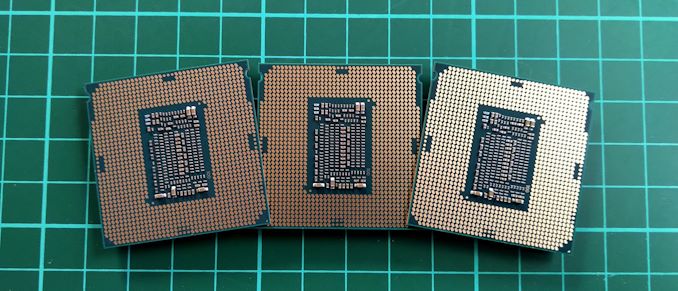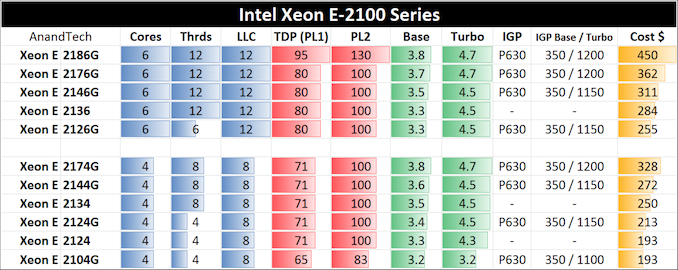The Xeon Entry Quad-Core CPU Review: Xeon E-2174G, E-2134, and E-2104G Tested
by Ian Cutress on March 11, 2019 10:30 AM EST- Posted in
- CPUs
- Xeon
- Enterprise CPUs
- Coffee Lake
- Xeon E
- C246
Quad Core Xeon-E Conclusion
In this review, we focused on the results from our quad core Xeon E testing. These processors form part of Intel's portfolio that caters to small and medium businesses that want managed office systems with reasonable performance, or for entry level SOHO servers or storage platforms. In this market, Intel is competing against AMD's Ryzen Pro line of CPUs.
The processors we tested for this review are Intel's first generation of Xeon Entry chips, which would have been the E3-1200 v7 family if it were not for the recent name change across Intel's processor lines. This hardware is based on Intel's Coffee Lake microarchitecture, the latest generation of Intel's 14nm family of processors, and Intel offers a variety of quad and six core parts, some with integrated graphics and some without.
By and large, we weren't expecting to see anything crazily radical with the E-2174G, the E-2134, and the E-2104G that we tested for this review. The results are run of the mill, and the E-2174G sits at the top of the other quad cores in all tests as we expected it to.
The E-2104G is perhaps the odd one out here, as it doesn't form part of Intel's regular Xeon E product family. This processor is classified as 'off-roadmap', which means it wasn't part of Intel's original plan and it was built for specific customers with requests for specific performance levels or to hit a certain price point. These chips rarely find their way to retail, and being the lowest processor of the Xeon E quad core line, it certainly performs as such.
Users who need Xeon E parts are typically looking for prebuilt machines with mainstream levels of performance but have requirements for manageability and/or ECC memory. Without any of those requirements, Intel's consumer processor line offers more system performance and higher specs for the same system price. AMD's Ryzen Pro line are an alternative to Xeon E, offering manageability through the DASH interface, and scale from quad core to eight core. If we can get samples of the Ryzen Pro linen we'll test them as well to see how they stand up to Intel.
For users interested in the future of this processor line, that's a hard one to answer. We've seen hints that Intel might launch eight core versions of Xeon E, although we expected those in the market last year and they haven't materialised. We expect Intel to move to 10nm for its next gen processor line, however the earliest those will be ready seems to be 2020, and the mainstream Xeon E processors typically come out six to nine months after the consumer versions do, so we might be looking at the end of 2020 before the next generation of Xeon E are released (unless Intel surprises us in late 2019 with another generation on 14nm)
 |
We also reviewed the Xeon Entry six-core processors: Intel Xeon E Six-Core Review: |












29 Comments
View All Comments
artk2219 - Tuesday, March 12, 2019 - link
In what world is a GTX 1080 antiquated? Sure its not an RTX 2070+ but that doesn't mean its not in the same performance class. Especially since there is very little consumer software that supports raytracing.ondma - Tuesday, March 12, 2019 - link
In the world of testing *CPU* performance, where you want to most powerful gpu available to minimize gpu limitations. The 1080 is almost 3 years old, and even worse it is a vanilla 1080, not even the most powerful of its own generation, much less the new generation.bananaforscale - Saturday, March 16, 2019 - link
It's also common to all the test setups. If the GPU was changed to an RTX 2080Ti AT would have to benchmark all the systems again. Also, Xeons don't go into gaming systems, so the benefit would be questionable. Sure, you are right, but in a way that's kinda irrelevant.Foeketijn - Tuesday, March 12, 2019 - link
If only Supermicro/Tyan etc, would make an AM4 board. I would probably stop buying xeons. 24/7 build quality, IPMI, ECC and a 2D videocard and they have a new customer.I build two AM4 semi WS's and was reminded why I stopped messing around with consumer motherboards. Surprises everywhere. Bios hickups, misuse of power connections etc.
RSAUser - Monday, March 11, 2019 - link
These are Xeons, can't we add benchmarks like hosting a site and seeing how many requests it can handle? You know, things Xeons are actually used for (very rarely for gaming...)?That Wattage graph is great, no wattage/performance graph? Xeon lineup, as you stated, usually has strict power requirements, so I'd like to know the performance of those tests based on the power usage.
And why is there not Thread Ripper if that is the primary line-up these processors are competing with at that price range + ECC memory? (Even though the R5/7 seem to support ECC unofficially depending on the motherboard vendor)
SaturnusDK - Monday, March 11, 2019 - link
If in doubt. All Asrock AM4 MBs support unbuffered ECC RAM. All of them.mode_13h - Monday, March 11, 2019 - link
Thanks.GNUminex_l_cowsay - Monday, March 11, 2019 - link
Naming a level of graphics settings, IGP, was a bad idea. Frame rates in Civ6 are an uninformative metric of CPU performance, even for the purpose of playing Civ6.mczak - Monday, March 11, 2019 - link
The conclusion why the E-2104G doesn't reach its TDP is very much incorrect. Most of that delta to the other chips will be due to the low clocks (without turbo), only a small fraction of it will be due to missing HT.(And, FWIW, if you want to really see the max power, you'd also have to run a 3d app like furmark simultaneously, I don't think this was done. Possibly for the other chips it wouldn't make much of a difference, if they stick to their limits, but I'm pretty sure for the e-2104G the power draw would increase substantially. Of course though there's merit in full cpuload only power too, but this isn't the maximum the chip will use.)
mooninite - Monday, March 11, 2019 - link
You should add a section about how to buy these CPUs because they're not retail CPUs. Newegg had them listed for about a month before taking them off.Since these are marketed as workstation / entry-server chips why are there no video encoding, SQL, or Java/PHP processing benchmarks?
Video encoding in particular (VP9) using VAAPI would be helpful.